UK Budget: 7 Takeaways for UK Pension Schemes
- Significant increases in taxes, spending and borrowing were announced.
- The future path for monetary policy will depend on revised growth and inflation forecasts by the Bank of England.
- A larger- than- expected cumulative increase in borrowing over the next 5 years may lead to significant increases in gilt yields.
- The inheritance tax treatment of pension pots will affect incentives to contribute and withdraw from pensions.
Following the UK budget on the 30 October, we took an in-depth look at the details of the changes announced by the Treasury and the analysis provided by the Office of Budget Responsibility, and have summarised the most relevant points for pension schemes below.
Takeaway 1: Changing Incentives to Contribute to Pension Schemes
Despite much speculation ahead of the Budget, pension schemes were not directly affected by the policy measures announced. However, there are some important points to consider, which risk having some unhelpful and unintended consequences.
Removing the inheritance tax exemption from pension pots from April 2027 may reduce the incentive to both contribute to pension schemes and increase the incentive to draw from them upon retirement, although this largely impacts members with large pension pots who use them as part of their estate planning. Those who plan to use their pension pots to fund their retirement will not be impacted. The changes also make it more likely that members will withdraw their full tax-free allowance at retirement. And if members chose to privately invest this amount, they may pay more in investment management fees overall.
The increase in employer national insurance contributions (NICs) may also impact the contributions employers make to their employees’ pension schemes. On one hand, if there are higher costs to be borne by employers, their ability to make additional contributions to pension schemes may be impaired. On the other hand, salary sacrifice schemes are now likely to be viewed as an even more tax-efficient benefit for employers to provide, as employer NICs do not apply to pension scheme contributions.
While the chancellor did not announce more radical reforms of the pension sector, we now expect her to address this in her Mansion House speech on 14 November.
Takeaway 2: Increase in Government Spending
Spending as a share of gross domestic product (GDP) is forecast to rise from 44.9% last year to 45.3% this year, before falling back slightly to 44.5% in 2029–30 – 4.9 percentage points higher than the pre-pandemic level. Around two-thirds of the increases in spending have been allocated to current spending, with the remaining third allocated to capital spending.
Figure 1: Public Spending as a Share of GDP
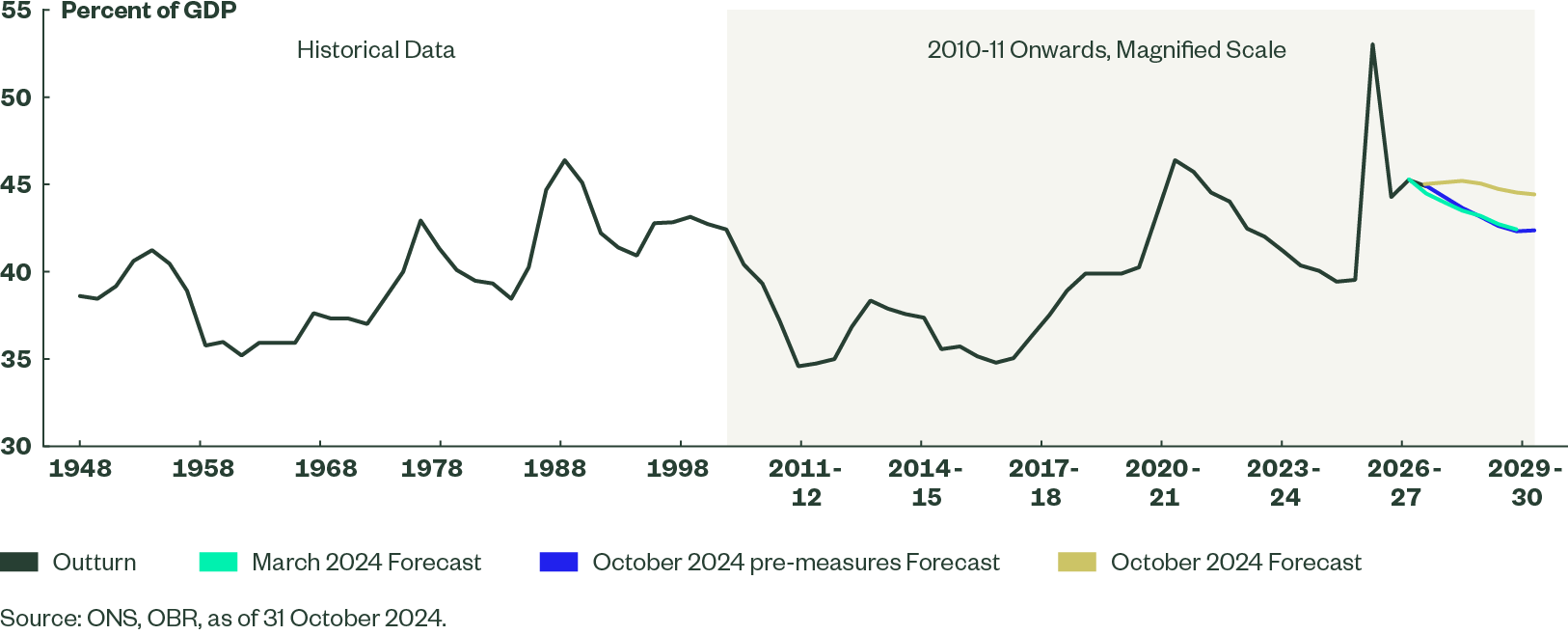
Takeaway 3: Increase in Taxes
With the full range of tax increases announced, taxes are now expected to reach historic highs as a share of GDP. Total revenues are expected to increase by £36.2 bn a year, on average, and £41.5 bn by the end of the decade. The primary tax-raising measure was the increase in employer NICs, via both a higher rate and a lower contribution threshold, which is expected to raise approximately £25.7 bn by the end of the decade.
Figure 2: National Accounts Taxes as a Share of GDP
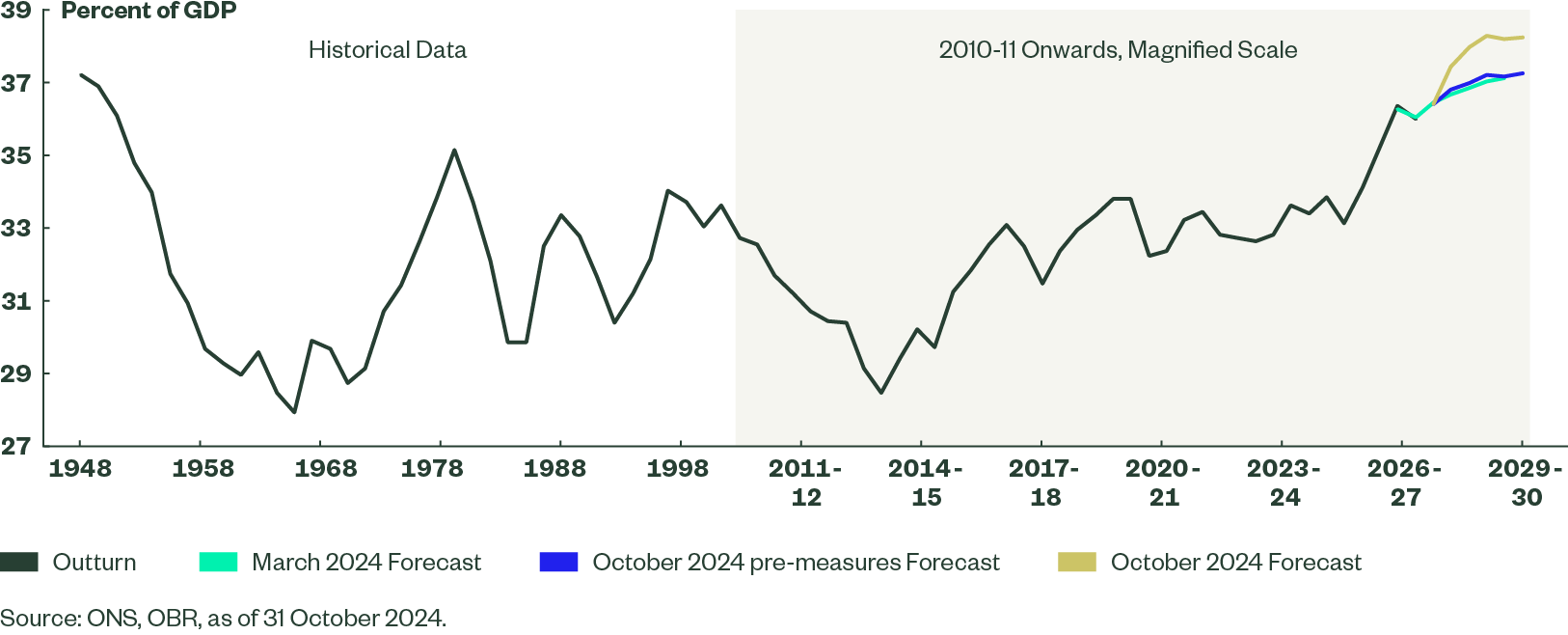
It is worth noting, however, that this is a common trend across countries, reflecting the pressures on public finances over the past 20 years.
Figure 3: Tax Take in the UK, G7 and EU14
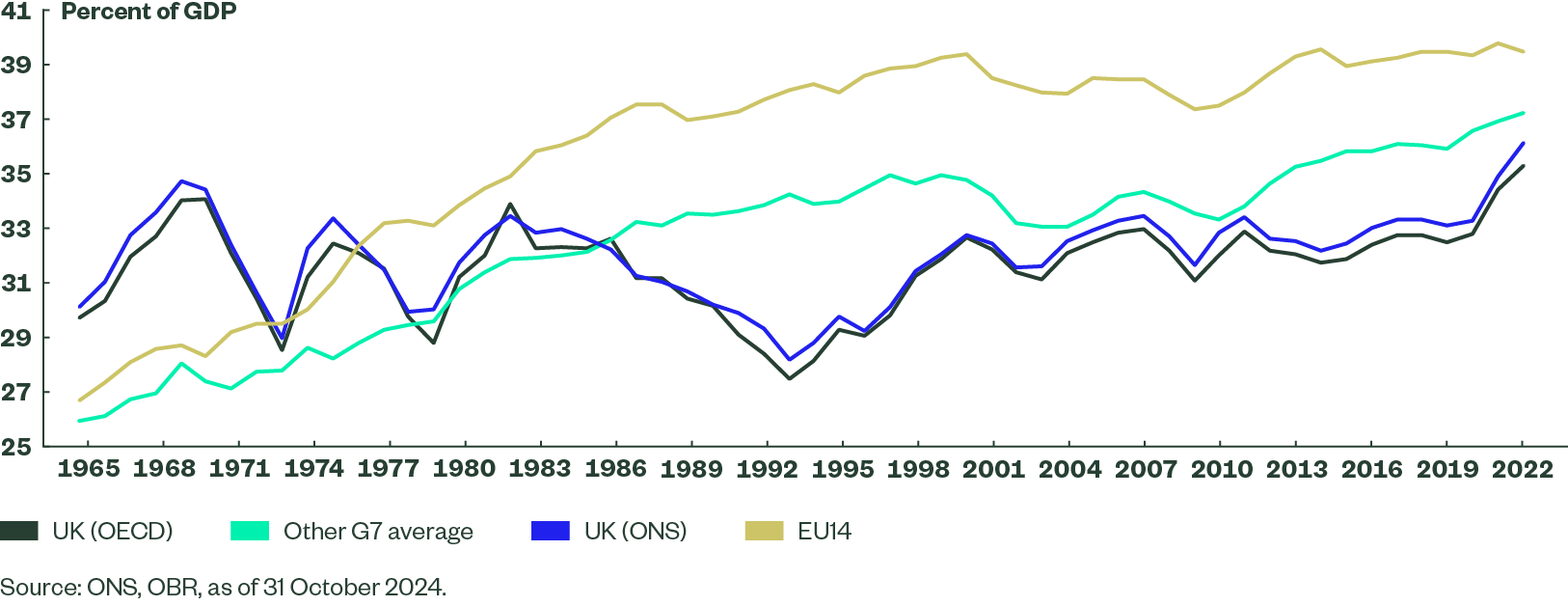
Takeaway 4: Borrowing to Increase
Borrowing is now expected to be approximately £32bn/year higher on average over the next 5 years, primarily as a result of the announcements made in today’s budget. This cumulative increase in borrowing was higher than markets had expected.
Figure 4: Public Sector Net Borrowing
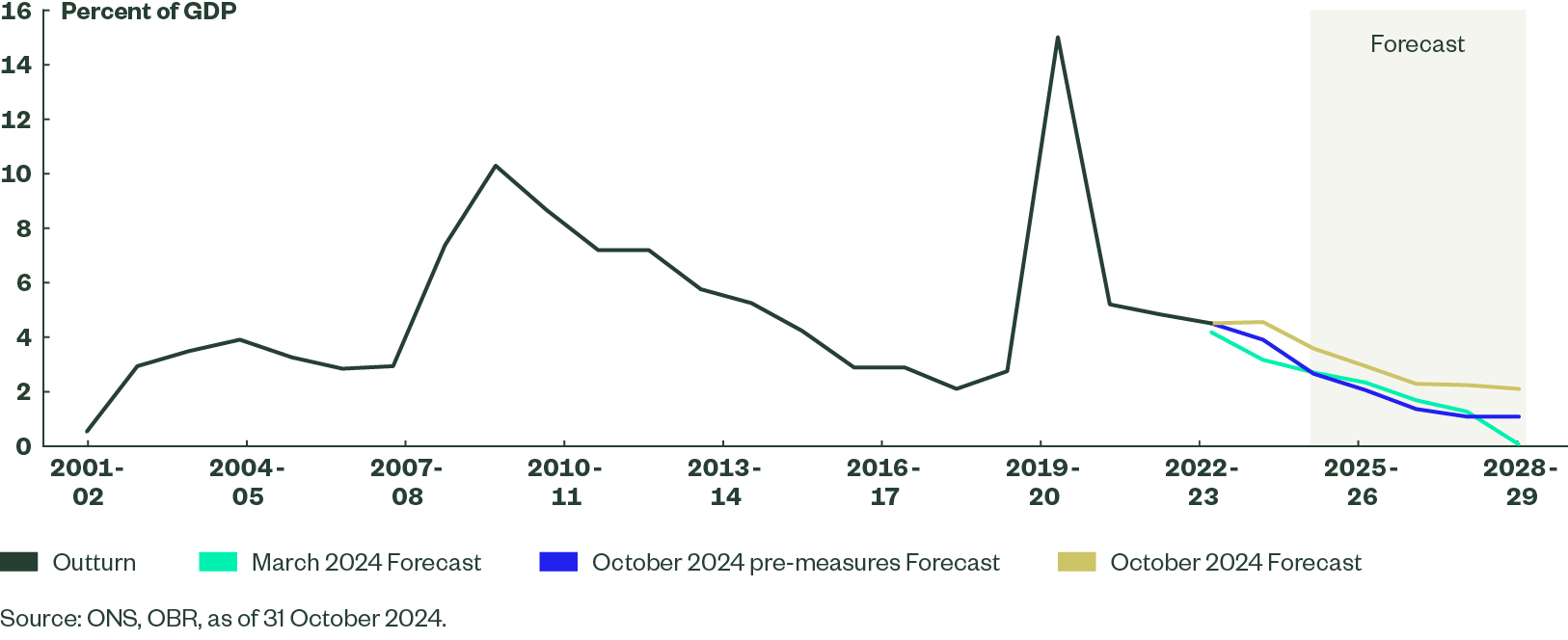
The high levels of government debt, coupled with high interest rates, means that debt service costs will remain at historically high levels. As a result, further increases in gilt yields may challenge the government’s ability to meet its fiscal rules.
Figure 5: Debt Interest Spending Relative to GDP and Revenues
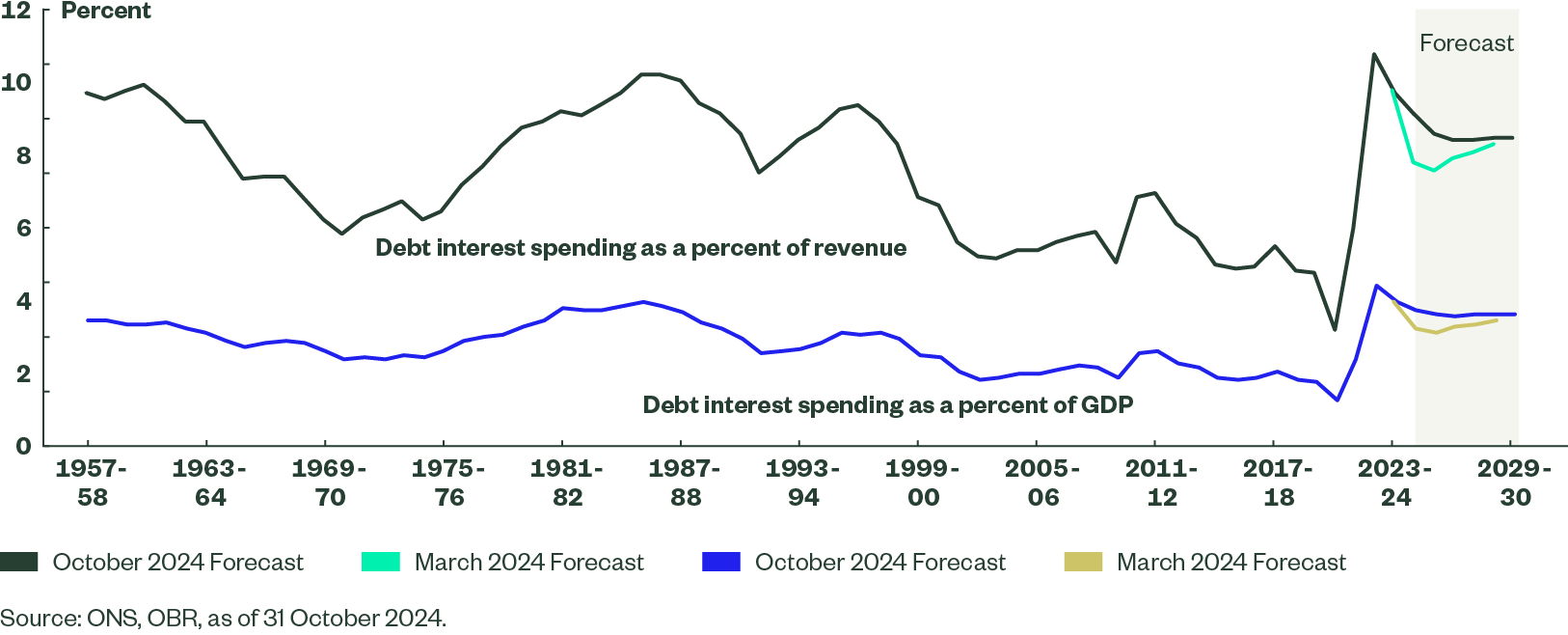
Takeaway 5: Amended Fiscal Rules
The government announced new fiscal targets in this budget:
- Current Budget (revenues - day-to-day spending) to be in surplus by 2029–30 (until 2029–30 becomes the third year of the forecast period, from which point the mandate applies to the third year).
- A supplementary target for public sector net financial liabilities (PSNFL) to fall as a share of GDP by 2029–30 (this applies until 2029/30 becomes the third year of the forecast, from which point this target applies to the third year).
While the adoption of PSNFL as the measure of government finances provides slightly more headroom, this is primarily because it includes illiquid financial assets and liabilities, such as student loans. However, it does not account for the value of physical assets, such as schools and hospitals, and therefore, when considered in isolation, encourage greater public sector investment. It is also worth noting that governments can alter the classification of spending between current spending and capital spending (such as repairing existing buildings) to meet their fiscal targets and these measures may not affect potential growth as much as expected.
The adoption of a three-year debt target is in theory a more binding and constraining target, as it means that governments can no longer rely on unspecified spending cuts beyond the scope of the regular three-year spending reviews, to meet its fiscal targets. However, given how regularly fiscal rules have been revised and the little headroom that the Chancellor has left, investors should not take too much comfort from this measure.
Takeaway 6: “Significant and Sustained Loosening of Fiscal Policy…”
The OBR believes that the budget delivers a “significant and sustained loosening of fiscal policy” and that in turn delivers significant changes to its growth and inflation forecasts. The boost to growth is largely front-loaded, with the majority of boost delivered over the first two years. Policy measures are also forecast to boost consumer price index (CPI) inflation by 0.4% in 2025–26 and 0.3% in 2026–27.
The OBR’s new forecasts now suggest there is a relatively small output gap (difference between current output and potential output), and it is now expected to turn positive in 2026. As a result, the OBR forecasts now suggest the Bank of England may not need to cut interest rates as much as it had previously expected.
It is important to note, however, that the Bank of England will make its own assessment of the economy and the impact of fiscal policy and is also likely to rely more on real-time data when deciding on the appropriate stance to take on monetary policy.
Takeaway 7: Increase in Gilt Supply?
The initial reaction in the gilt market was a marked increase in yields across the yield curve, as the market moved to price in both a sustained increase in gilt supply over the coming years, as well as the potential for less monetary policy easing from the Bank of England. When considering active quantitative tightening from the Bank of England, effective net gilt issuance will continue to run at elevated levels over the coming years.
Gilt yields also rose relative to interest rate swap rates, to reflect this increase in supply. We also saw inflation breakevens rise, as more of the burden of the extra issuance will be carried by nominal gilts, rather than index-linked gilts.
Finally, one important area to watch is repo markets. We had previously written about the impact of quantitative tightening on repo markets, and the increase in supply of government bonds globally, including the UK, is likely to tighten conditions in funding markets further.